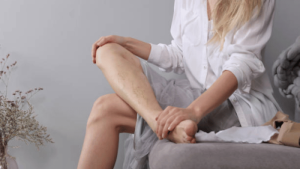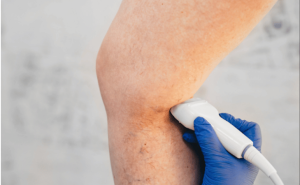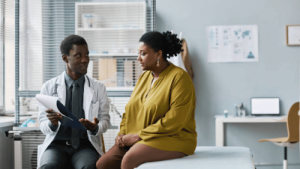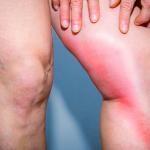
Are you worried about spider veins on your feet and ankles?
Spider veins are not usually a serious health issue on their own. They’re often more of a cosmetic concern, although they can certainly affect self-esteem. Still, seeing clusters of veins on the leg, feet, or ankles isn’t something you should ignore. Spider veins can be a sign of an underlying condition affecting vein health.
If you are considering treatment for spider veins or are still determining when to consult a vein specialist, keep reading. This guide covers everything you need to know about spider veins on the ankles and feet, including causes, symptoms, and treatment.
Understanding Spider Veins
Spider veins are dilated capillaries—small blood vessels—in the skin. They are also known as telangiectasias or thread veins. Spider veins look like thin webs of branch-like veins and can be red, blue, or purple.
Spider veins can be seen clearly near the skin’s surface, but they don’t appear raised or bumpy like varicose veins do. Although spider veins are similar to varicose veins, they are comparatively smaller and less likely to cause physical symptoms like leg heaviness, aching pain, or swelling.
Spider veins are more common on the legs and face, but they can appear on other areas of the body, including the ankles and feet.¹
Causes of Spider Veins in Ankles and Feet
When blood vessels become damaged, they can enlarge and become more easily visible. If this occurs in capillaries near the skin, spider veins can be the result. More serious damage affecting larger veins can cause blood to pool and swell up, leading to varicose veins. Both spider veins and varicose veins are classified on a scale of vein disease.²
Anyone can develop foot or ankle spider veins if the capillaries in these body parts become damaged. High blood pressure, hormone shifts, and the wear and tear of aging can harm the delicate capillaries underneath the skin.
If you’re impacted by any of the following potential factors affecting spider veins, you may want to pay greater attention to your vein health and consult a vein specialist if you have concerns.
Genetic Predisposition
Studies show that about 90% of people with spider veins have a family history of the condition.² So if you have a close family member with telangiectasia, such as a parent or sibling, you’re more likely to have similar vein issues.
Prolonged Standing or Sitting
Blood can pool in the leg veins after long periods of sitting or standing. This extra blood volume can increase the pressure on the walls of blood vessels in the feet, legs, and ankles, causing them to stretch or swell.
Hormonal Changes
When hormones shift because of pregnancy, menopause, the use of birth control pills, or other causes, blood volume changes, and vessel walls can weaken, leading to stretched or damaged veins.
Along with standing for long periods at work and genetic predisposition, high levels of the hormone estrogen are one of the most common risk factors for spider veins.³
Obesity
When someone is overweight, the heart has to work harder to pump blood throughout the body. As a result, blood pressure increases, and that extra pressure can damage vein walls and valves. That’s why many people who are overweight or obese also have vein disease and are impacted by both spider and varicose veins.4
Injury or Trauma to the Ankle or Feet
Injury or trauma from surgery can also cause ankle spider veins. Broken capillaries, which might appear like a rash or a cluster of thin red or purple capillaries, can also lead to spider veins.
Aging
As the body ages, the valves in our veins become weaker from wear and tear. When the valves don’t work properly, blood can flow backward, leading to the pooling of blood in the ankles, feet, and legs and causing stretched and damaged veins.
Environmental Factors
Sun damage over long periods of time can also cause spider veins. UV rays can harm the blood vessels close to the skin, weakening the walls and worsening the issue with spider veins.
Symptoms of Spider Veins on Feet and Ankles
Spider veins usually don’t cause pain or other uncomfortable symptoms like varicose veins do.² So for many people with spider veins, the only symptoms are the visible red, blue, or purple veins on legs, feet, ankles, and other areas.
However, if underlying vein disease progresses further, more serious impacts on vein health and blood circulation can result. Possible symptoms from these conditions include the following:
- Swelling of the legs, feet, and ankles
- Tingling of the feet and ankles
- Itching skin, burning, and skin rashes
- Heaviness or fatigue in the legs
- Aching or throbbing pain in the lower extremities
- Restless legs
- Calf cramps that worsen at night
Diagnosis of Spider Veins
To diagnose vein conditions, a vein doctor will perform an exam to evaluate the condition of the veins, determine whether there is any vein damage, and identify which veins are impacted. While spider veins usually aren’t harmful, they could be related to more serious cases of vein disease.
The vein specialist will carefully inspect the appearance of veins on the feet, ankles, or other body areas. They’ll also ask about symptoms such as leg pain, swelling, or skin changes.
Because many veins are deep under the skin, the exam may involve ultrasound imaging to map out more veins and track blood flow. Venography, an X-ray procedure that takes pictures of the veins, is another imaging tool that vein doctors use.
Managing Foot and Ankle Spider Veins
So what should you do if you have spider veins on your ankles or feet?
It may be wise to consult with a vein specialist. They can assess the overall health of your veins, provide an accurate diagnosis, and create a personalized treatment plan to help you get rid of spider veins and any vein symptoms.
But you can also take steps to help keep your veins as healthy as possible and limit the progression of vein symptoms. Here are five tips that can help you manage vein health:
- Stay active: If you have to sit at a desk or stand for long periods, spend a few minutes at least every hour moving around, stretching, and getting your blood flowing.
- Elevate your feet: Putting your feet above your heart is a great way to improve blood circulation.
- Improve your diet: Eating more nutrient-packed fruits, veggies, nuts, and whole grains, while also drinking plenty of water can support your vein health.
- Massage your feet: Rub your feet and ankles before bed to increase blood circulation and relieve swelling.
- Wear compression stockings: Compression stockings help your veins pump blood back toward the heart, reducing fluid retention in the lower extremities and keeping your veins healthy.
Treatment Options for Spider Veins
While tips for managing spider veins can relieve symptoms and help prevent more ankle and foot spider veins from developing, only medical treatments can eliminate spider veins and address the root cause of vein issues.
Vein specialists can target the damaged veins, eliminating the cosmetic and physical concerns related to this vein issue. The damaged vein will close up and disappear, while other healthy veins will pick up the slack.
At USA Vein Clinics, we offer visual sclerotherapy, an effective treatment for spider veins anywhere in the body. It’s a minimally invasive procedure that involves injecting a medical solution into damaged veins.
Our vein doctors also provide multiple treatments for vein disease, including endovenous laser treatment (EVLT) and radiofrequency ablation (RFA) treatments for varicose veins. View our treatments to learn more.
When to See a Doctor About Spider Veins on Ankles, Feet, or Legs
If you have spider veins along with other symptoms, such as varicose veins, leg pain, swelling of the feet or ankles, and frequent cramps in your legs, it’s important to see a vein doctor to find out what’s causing your symptoms and get a treatment plan to improve your vein health.
If your spider veins are only a cosmetic concern, you can still consult a vein doctor for an evaluation and learn more about your treatment options.
Even minor spider veins won’t go away on their own. And, if vein disease is left untreated, more painful symptoms may appear. Vein disease also increases the risk of serious complications like deep vein thrombosis (DVT) and venous ulcers. The earlier you see a doctor, the easier it is to treat vein damage, alleviate symptoms, and get you back on track with healthy veins.
USA Vein Clinics has over 160 vein clinics nationwide staffed by leading vein specialists. Find a location near you today to schedule a consultation.
Frequently Asked Questions
Should You See a Dermatologist or a Vein Specialist for Spider Veins?
You should see a vein specialist because they specialize in treating the underlying cause of spider veins, not just surface symptoms.
Vein specialists, also known as vascular specialists or vascular surgeons, treat health concerns related to the veins, including spider veins and varicose veins. They can offer expert care to help alleviate painful vein symptoms and create a personalized treatment plan to support overall vascular health. They can also perform treatments to address cosmetic concerns related to the veins.
Are Spider Veins Dangerous?
Seeing a few spider veins on your feet or ankles isn’t necessarily a cause for concern. However, they could be related to chronic venous insufficiency, which can lead to more severe vein problems. Vein doctors examine a person’s overall vein health and can provide treatments.
What Happens if Spider Veins Are Left Untreated?
Untreated spider veins can sometimes lead to uncomfortable symptoms, including itching, burning skin, and leg pain. Spider veins can be related to other forms of vein disease related to poor circulation, which can impact the body in various ways, including an increased risk for blood clots.
What Is the Best Way to Get Rid of Spider Veins?
The best way to eliminate spider veins is to treat the root cause: vein disease or chronic venous insufficiency.
At USA Vein Clinics, our doctors use minimally invasive procedures that target damaged veins. We can evaluate vein health using advanced ultrasound imaging and develop a treatment plan to eliminate spider or varicose veins. Destroying damaged veins can improve blood flow, prevent vein disease symptoms from worsening, and improve self-confidence.
MORE QUESTIONS? TALK TO A VEIN SPECIALIST TODAY
Sources
- “Varicose Veins and Spider Veins,” Office on Women’s Health at the United States Department of Health and Human Services, last modified February 15, 2021.
- Darren P Sandean and Ryan Winters, “Spider Veins,” in StatPearls [Internet] (Treasure Island, FL: StatPearls Publishing, 2024).
- Neil S Sadick, “Predisposing factors of varicose and telangiectatic leg veins,” The Journal of Dermatologic Surgery and Oncology,18 no. 10 (1992): 883–886.
- Huw O Davies, Matthew Popplewell, Rishi Singhal, Neil Smith, and Andrew W Bradbury, “Obesity and lower limb venous disease – The epidemic of phlebesity,” Phlebology 32 no. 4 (2016): 227–233.








